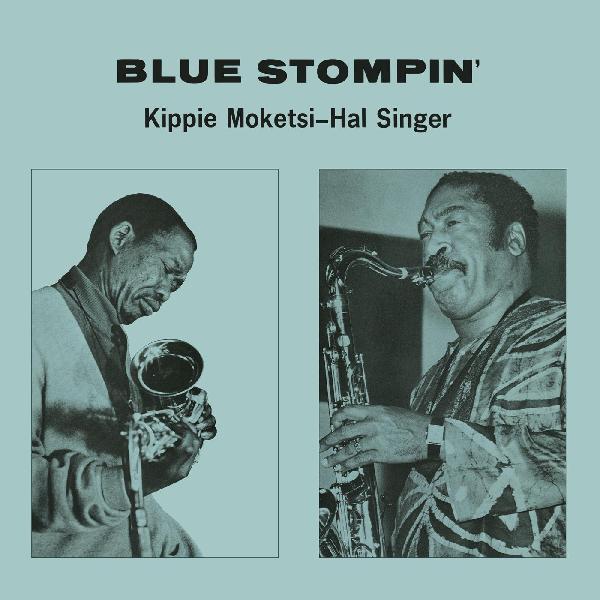Ninety-six years ago last week (the biographies disagree on whether July 25 or July 27), saxophonist Jeremiah Morolong “Kippie” Moeketsi was born. To mark the occasion, Canadian label Wearebusybodies reissued the long out of print 1977 As-Shams album Blue Stompin’ https://wearebusybodies.bandcamp.com/track/blue-stompin.
Not surprisingly, vinyl has already sold out, though the digital reissue remains available.
The headliners play together – recorded as part of a 1974 US State Department-sponsored jazz tour – only on the first, title, track, supported by Singer’s American rhythm section, Gus Nemeth on bass, Alain Jean-Marie on piano and Oliver Johnson on drums.
The remaining three tracks are a showcase, in various combinations, for As-Shams’ stellar South African jazz stable: Barney Rachabane and Duku Makasi on reeds, Pat Matshikiza and Jabu Nkosi on keys, Sipho Gumede on bass and Gilbert Matthews on drums.
Liner notes were by Drum magazine’s then jazz editor Joe Tholoe; the cover photograph of a pensive Moeketsi cradling his horn inspired artist Thami Mnyele’s later graphic representation of the musician.
This has been the cue for some overseas reviewers to rehash all the tired Moeketsi mythology (see, eg, the London Financial Times at https://www.ft.com/content/03c8a833-ccb9-46f5-b749-ed692e984030 ) about the reedman’s drunken belligerence and years spent in an “alcoholic haze”.
Myths are based on real events. Nobody denies that Moeketsi drank too much. Few of the re-hashers, though, tell the other parts of the story. Moeketsi’s proud and articulate nationalism, his refusal to stay silent about exploitative working conditions, and the fact that the electro-convulsive therapy (ECT), administered as “treatment” when he was with King Kong in London, seriously messed with his mind for years after. (Even with today’s far more sophisticated applications, MIND, the UK mental health charity reports “loss of creativity…difficulty concentrating” as possible long term ECT side effects https://www.mind.org.uk/information-support/drugs-and-treatments/electroconvulsive-therapy-ect/side-effects-of-ect/ )
The story of that ECT, in Kippie’s own words (Staffrider, November 1981 https://disa.ukzn.ac.za/sites/default/files/pdf_files/stv4n381.pdf ), and an English doctor’s philistine diagnosis of the stresses felt by a creative Black South African surviving under apartheid, is so heartbreaking it’s hard even to read.
“One day, the doctors took me to a concert…They suspected that I thought too much musically…that my liking of music could have been one of the causes of my sudden illness that made me to be not quite normal” When Kippie was driven, cheering, to his feet by the quality of the playing – no surprise: it was the Oscar Peterson Quartet with Ella Fitzgerald – “The doctor said ‘No, Kippie, I think you’re still not awright’… I was discharged having been given treatment – like electric shock – three times. That thing can make you stupid, man. It makes you become forgetful. Even now, I’m like that, forgetful …But the doctor said it would do me good…I would eventually become insane if I kept on thinking too much about music.”
Those were among the demons Moeketsi spent subsequent years battling. As Tholoe wrote in the original liner notes:
“[I]nto this story some will read a curve: from Kippie teaching himself music by imitation, to a climax of artistic achievement and renown in this country, and then the decline… Others will read a lifetime of involvement, in spite of personal problems. Count me among the latter. A life-time of involvement: Kippie was among the few who understood bebop while the rest of us were still doing the jitterbug to the sounds of swing. In his way he made us see what it was all about. He has seen a generation of colleagues go to join the Orchestra Up Yonder, or merely leave their horns to spiders and their webs while they got on the straight and narrow path of grandfather-hood and six to six jobs at factories. Kippie continues on the wide, wide – often unappreciated – road, creating music.”
The rest of Blue Stompin’ is a lovely album that adds lustre to the reputations of all the South Africans who contributed. Moeketsi alongside Singer in the ensemble plays sweet, bluesy, but fairly restrained. He had those old-school bandstand manners, those who remember him told me: if you’re welcoming a horn guest to South Africa, you give his music the space.
But the first one minute 20 seconds are like nothing you’ll ever hear again.
They are filled by an unaccompanied fanfare from Moeketsi’s horn. Anguished and impassioned, it tells his story and the stories of all our jazz heroes who resisted oppression. This is who I am, it sings. Listen and you’ll hear it all: apartheid’s attempts to crush the creative Black spirit, the levels of musical attainment he nevertheless achieved, and that British mental hospital’s attempt to torture the music – often the only thing that kept Black artists anywhere near sane under such ugly conditions – out of him. For that gigantic, intelligent, beautiful and moving fuck-you alone, you must hear this album.



Ay Sis G I love these historical insights that you so kindly provide – more power to your pen Ma’am. However I find the lack of credits for the photographers a little disconcerting. I mean I know who did the moody, smokey pic on the stairs of Dorkay House … but who else is aware of its creator? Hopefully this is seen in a constructive light (pun intended). Thanks always and hope to see you soon
LikeLike